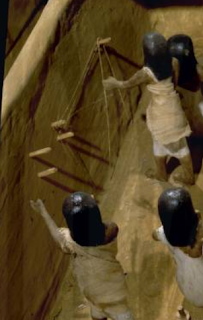Last week, I blogged about the ground looms used by ancient Egyptians. This week consideration is given to how they warped the loom, that is, how were the longitudinal fibres put on the loom. Modern weavers using simple looms tend to use two different methods: direct warping where the thread is would backwards and forwards around two parallel beams, or often an indirect method is used there the weaver winds the length of thread between poles/pegs and then transfers it to the loom. Because of the number of warp threads per centimeter is estimated as 30 on average, it has been suggested it would have taken about 3 days to warp the loom.
A video of modern direct warping of a simple loom can be seen here:
https://youtu.be/6OY17Kjo5dc?t=312
You can see modern weavers using warping pegs here:
https://youtu.be/IyOSwtY-Gnk?t=85
https://youtu.be/R2JlgXorWeg
Pegs can be hammered into the ground, put on a frame or into a wall.
It seems likely that in ancient Egypt different methods were used at different times and places. However, there is evidence of indirect warping.
To the left is a model of a weavers workshop from the tomb of Mekhetre. I've showed this image before in other posts. It dates to around 1980BC. On the left in the picture you can see pegs stuck into the wall. It has been suggested that these are warping pegs. The first picture on this page shows a close up of the warping section.There are also one or two tomb depictions which have been seen as warping tough they are difficult to interpret.
For example, below is a scene from the tomb of Nefer-Renpet from around 1200 BC. It has been suggested that the vertical forked sticks are warping pegs.
Peet and Woolly in their report on the Workmen's Village at Amarna claimed that the several pegs found in houses were warping pegs (COA I, 55).
As you can see by the videos above, warping pegs are not confined to ancient societies. Below is a depiction of the laying out of a warp in a wall in modern Egypt (with apologies as I don't know where I got the picture!).
Further Reading
Kemp, B.J. and Vogelsang-Eastwood, G. 2001. The Ancient Textile Industry at Amarna, The Egypt Exploration Society, pp.314-322.
Peet, T. E. and Woolly, C.L. 1923. The City of Akhenaten, Part I, Excavations of 1921 and 1922 at el-Amarneh. The Egypt Exploration Society.




No comments:
Post a Comment